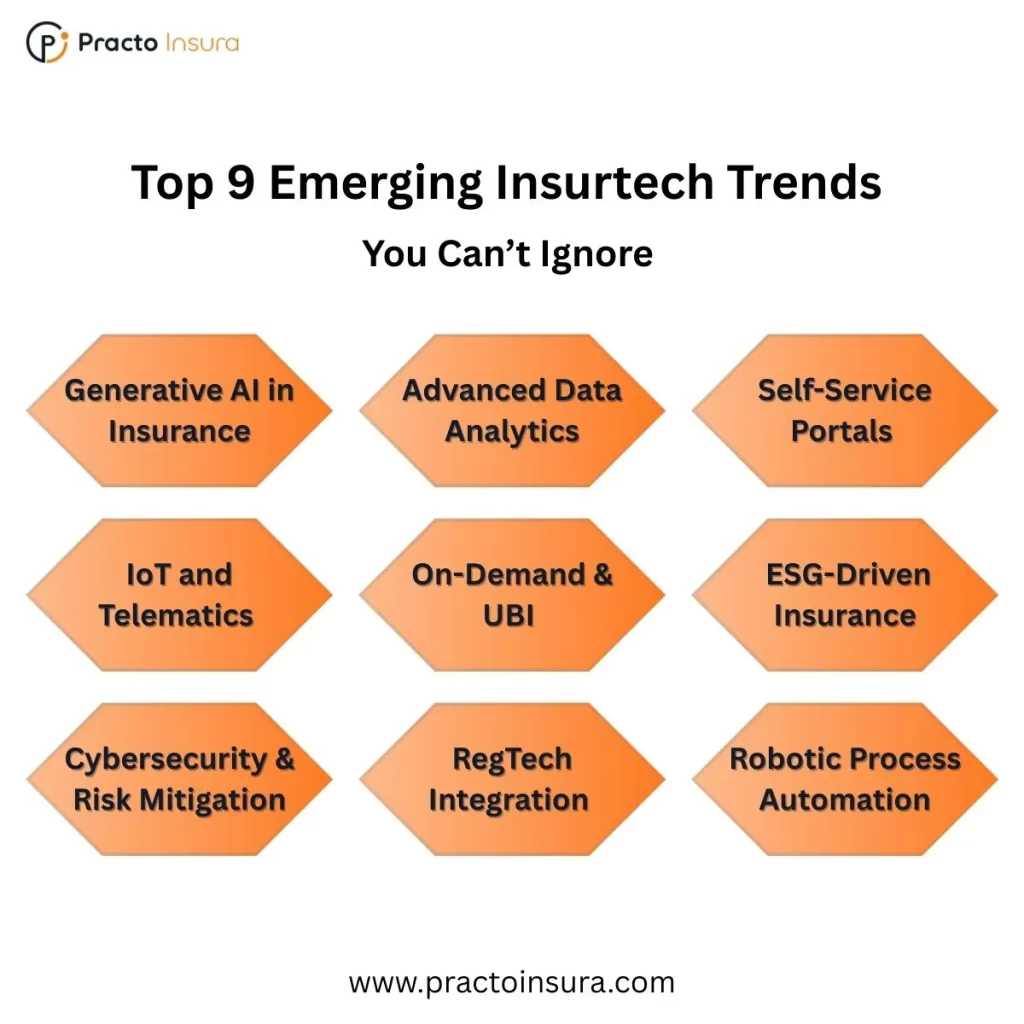Top 9 Emerging Insurtech Trends You Can’t Ignore in 2025
The insurance industry is undergoing a digital transformation like never before. Technology is altering not only how insurers function but also what consumers expect, from AI-powered decision-making to highly customized policies. As we move into 2025, insurers must evolve or risk becoming obsolete. The future belongs to agile, tech-enabled companies that prioritize data, personalization, efficiency, and trust.
9 Insurtech Trends You Can’t Ignore

1. Generative AI in Insurance
Generative AI is changing how insurance companies work behind the scenes. It can write policy documents, respond to customer questions, and even simulate claim situations – all without human help. This cuts down on the time staff spend on repetitive tasks and helps reduce operating costs. One McKinsey report suggests that AI could automate up to 50% of claim-related tasks, significantly cutting operational costs and reducing processing times.
But it doesn’t stop there. Insurers are also using AI in fraud detection, understanding which customers might leave, and suggesting better coverage options based on someone’s history. When used the right way, generative AI helps teams work faster, serve customers better, and stay ahead in a very competitive industry.
2. Advanced Data Analytics
Advanced analytics gives insurers the power to make smarter, faster decisions by using real-time data instead of relying only on historical trends. Unlike traditional models, predictive analytics looks at patterns in customer behavior, sensor data, online activity, and more to forecast future risk. This allows insurers to identify high-risk applicants early, price policies more accurately, and detect fraud before it becomes a costly claim.
In today’s fast-moving market, using data in the right way can make the difference between profit and loss. With tools that simulate “what-if” scenarios, insurers can prepare for everything from natural disasters to sudden changes in customer demand. Companies that use predictive analytics tend to be more stable, efficient, and ready to adapt. It’s not just a nice-to-have; it’s a must-have if you want to stay competitive and build long-term growth.
3. Self-Service Portals & Mobile Apps
Customer habits have changed. People now expect to manage their insurance the same way they handle their banking or shopping: quickly, easily, and on their own terms. That’s where self-service portals and mobile apps come in. Practo Insura offers an Insured Portal as part of its Policy Administration Suite, enhancing customer engagement by providing a customizable platform for policyholders to manage their insurance needs efficiently.
For insurers, this shift offers major benefits too. When customers handle routine tasks themselves, it lowers the number of incoming calls and emails, saving both time and money. More importantly, it improves the overall experience, making policyholders feel more connected and confident. As digital habits continue to grow, offering easy self-service isn’t just a bonus – it’s becoming the new standard for building long-term trust.
4. IoT and Telematics
IoT devices and telematics are transforming how insurers assess risk: instantly and more accurately. Whether it’s a connected car sending data about driving habits or a wearable device tracking someone’s health, these tools provide real-time behavioral insights. Statista reports that over 250 million telematics devices were used in auto insurance globally in 2024, and the number continues to grow. With this data, insurers can offer usage-based insurance plans that adjust pricing based on how safely someone drives, rewarding low-risk behavior.
But the impact goes beyond pricing. IoT also helps prevent damage before it happens. For example, smart home sensors can detect things like water leaks or smoke early and send alerts to the homeowner. This proactive approach is proving effective. IoT-enabled insurance has been shown to cut claim frequency by up to 30% in some property lines. It’s a win-win: customers are better protected, and insurers reduce avoidable losses.
5. On-Demand & Usage-Based Insurance
In 2025, flexibility matters more than ever – and that’s exactly what on-demand insurance delivers. Instead of paying for coverage year-round, people can turn it on only when they need it. This is especially useful for things like travel, part-time driving, gig work, or short-term stays. It’s a model that fits the lifestyle of today’s digital-first generation. Research from Allied Market Research projects that the global usage-based insurance market will reach $267.4 billion by 2032, growing at over 26.2% CAGR.
For insurers, this approach isn’t just about meeting customer needs – it also reduces unnecessary risk. Since pricing is tied directly to usage, policies become more accurate and fairer for both sides. In fact, studies show that 66% of millennials are more likely to choose flexible and personalized coverage options. By offering plans that adjust with life’s pace, insurers can attract new audiences and build a forward-thinking product lineup that’s built to last.
6. Sustainability & ESG-Driven Insurance
Environmental, Social, and Governance (ESG) values are becoming a core part of how companies operate – and insurance providers are no exception. Many are now factoring ESG scores into their underwriting and creating green-focused policies, like those that support clean energy or protect against climate risks. Reports show that insurers who follow ESG principles tend to perform better financially. Both customers and investors are paying closer attention to how responsible and sustainable a company truly is.
From offering discounts on eco-friendly homes to helping track carbon footprints, ESG-based products are gaining traction. For younger generations especially, values matter. Nearly 70% of Gen Z and millennials say they prefer brands that take sustainability seriously. For insurers, this shift isn’t just about keeping up – it’s about building trust, staying relevant, and shaping a future that’s both profitable and responsible.
7. Cybersecurity & Risk Mitigation
As insurers adopt more digital systems, cybersecurity becomes a top priority. Sensitive customer data, payment details, and operational infrastructure are all at risk without robust protections. According to IBM’s Cost of a Data Breach Report 2024, the average cost of a cyberattack in the financial services industry was $4.88 million. A breach not only impacts operations it erodes trust and invites regulatory scrutiny.
To counter these threats, insurers are integrating AI-driven threat detection, endpoint security, and multi-factor authentication. Many are also bundling cyber protection into their client offerings. Statista projects that the global cyber insurance market will exceed $30 billion by 2027. Strengthening cybersecurity is no longer just IT’s job-it’s a business imperative that protects your assets and opens up new product avenues.
8. RegTech Integration
RegTech, or regulatory technology, is helping insurers simplify how they handle compliance. With laws and reporting rules constantly changing across regions, keeping up manually is time-consuming and costly. RegTech tools step in by tracking updates, automating reports, and ensuring everything stays aligned with current regulations. A recent survey shows that 70% of compliance professionals expect even more regulatory pressure in 2025, making automation not just helpful, but necessary.
For insurers, this means fewer errors, faster onboarding, and smoother audits. It also frees up teams from routine tasks so they can focus on higher-level decisions. Some studies suggest that using RegTech can lower compliance costs by as much as 50%, especially for firms operating in multiple markets. With growing scrutiny from regulators, having these tools in place keeps your business compliant, efficient, and ready to adapt.
9. Robotic Process Automation (RPA)
Robotic Process Automation (RPA) is changing how insurers handle repetitive work. Tasks like entering data, renewing policies, or processing claims no longer need to be done by hand. Instead, bots can follow set rules to complete these actions quickly and accurately. A 2024 report showed that using RPA in insurance workflows can cut processing time by up to 70%, which makes a big difference, especially when managing high volumes of claims where timing really matters.
RPA is also getting smarter. When combined with AI, it can go beyond routine work and start making decisions or handling special cases on its own. A McKinsey study highlights that insurers using RPA report a 20-30% reduction in operational costs. Automating repetitive tasks not only saves money but also frees up your team to work on more important projects, which raises morale and productivity.
Wrapping Up
The insurance industry in 2025 is no longer just about protection – it’s about innovation, personalization, and smart decision-making. As technology continues to evolve, so do customer expectations. From AI and automation to ESG values and usage-based models, these nine trends highlight how insurers can stay relevant, efficient, and competitive in a rapidly changing market.
Adopting these Insurtech solutions isn’t just about keeping up with trends-it’s about creating a future-ready insurance business that delivers real value to customers while optimizing internal operations. Whether you’re looking to improve customer experience, streamline compliance, or unlock new revenue opportunities, now is the time to embrace these changes and lead the transformation from the front.
We specialize in developing innovative Property & Casualty (P&C) insurance software solutions, leveraging over 8 years of InsurTech expertise to simplify insurance operations and enhance efficiency.


